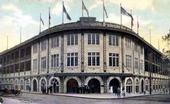1909 World Champion Pirates - first team to play in Forbes Field
Forbes Field was a Major League Baseball park in the Oakland neighborhood of Pittsburgh, Pennsylvania, United States. When it opened June 30, 1909, it became Major League Baseball's second steel-and-concrete stadium (Shibe Park being the first). Forbes Field's innovations included elevators, ramps, electric lights, telephones and trolley lines.
It served as the home of the Pittsburgh Pirates of the National League from mid-1909 to mid-1970. It was also the home field of the Homestead Grays of the Negro Leagues from 1939 to 1948. The Pittsburgh Steelers of the NFL (who were initially also called the "Pirates") used the stadium from 1933 to 1963, when they moved to nearby Pitt Stadium. The Pittsburgh Americans of the second American Football League also called Forbes Field throughout its two year existence (1936 and 1937). The University of Pittsburgh Panthers football team also used the stadium as their home field from October 16, 1909 until the opening of Pitt Stadium in 1925, winning several national championships, including three under legendary head coach Glenn Scobey "Pop" Warner.
Forbes Field was built under the direction of Pirates owner Barney Dreyfuss. It was named for General John Forbes, and is the only major league baseball park named for an officer in the French and Indian War. Forbes' contribution to the area was having captured Fort Duquesne, building the larger Fort Pitt was on the site, and naming the settlement around it Pittsburgh, after British statesman William Pitt the Elder.
Forbes Field replaced the wooden Exposition Park, and was one of the first steel-and-concrete baseball parks. It is the only home the Pirates have had that was not on the west bank of the Allegheny River, and is also by far their longest-lived, at parts of 62 seasons. It was in an attractive setting, with Schenley Park and a large ravine, Junction Hollow, beyond the outfield area. In its later years, the tall Cathedral of Learning on the nearby University of Pittsburgh campus afforded a breathtaking view of the ballpark. It is from that tower that many "aerial" photos of the ballpark were taken.
On May 25, 1935, the first home run was hit over the double-deck grandstand in right field, which, coincidentally, was Babe Ruth's 714th and final career home run. That was a target that Willie Stargell would breach a number of times early in his career with the Bucs. However, the most famous homer hit in Forbes Field was undoubtedly Bill Mazeroski's walkoff home run to win the 1960 World Series for the Pirates.
The flagpole and a portion of the left and center field walls still exist near Posvar Hall (formerly Forbes Quadrangle) on the campus of the University of Pittsburgh. A bronze plaque indicates the portion over which Mazeroski's 1960 blast traveled. Home plate is preserved under plexiglas in a hallway in Posvar Hall, which occupies much of the site; however, it is a few feet away from its original location, currently occupied by a women's restroom. On every October 13 (the anniversary of Game 7 of the 1960 World Series), local fans gather at the site and listen to a tape of the broadcast. Many diehard Pirates fans view this as one of the greatest moments in Bucs history. The portions of the wall that still stand are also still covered in the same ivy that decorated its left and center field walls for decades.
One artifact no longer there is the statue of John Peter "Honus" Wagner, the first great Pirates star and one of the five original inductees to the Baseball Hall of Fame. That statue, which shows Wagner at bat, completing his swing, was moved to the entrance to Three Rivers Stadium and later to the entrance to PNC Park.
Forbes Field had an exceptionally large outfield, and during its 61-year history it never witnessed a no-hitter. After the extension of the right field stands into the outfield during the mid-1920s, the dimensions were pretty well set for most of the next 50 years, except during 1947-1953 when an inner fence reduced the left field area by 30 feet, to assist Pirates sluggers like Hank Greenberg ("Greenberg Gardens") and Ralph Kiner ("Kiner's Korner"). The distance from home plate to the backstop was originally 110 feet (about 31 meters) but was eventually shorted to 75 1/2 feet (about 22 1/2 meters). The outfield of Forbes Field was unusual in that the bases of the light towers in the outfield were in play, as was the batting cage, and often the groundskeeping equipment. Balls hit into the batting cage or the groundskeeping equipment were ground rule doubles.
Forbes Field hosted four World Series (1909, 1925, 1927, 1960) and two All-Star Games (1944, 1959).
Score Card from 1909 World Series
1909 series brought together the two greatest players in the game - Ty Cobb & Honus Wagner
